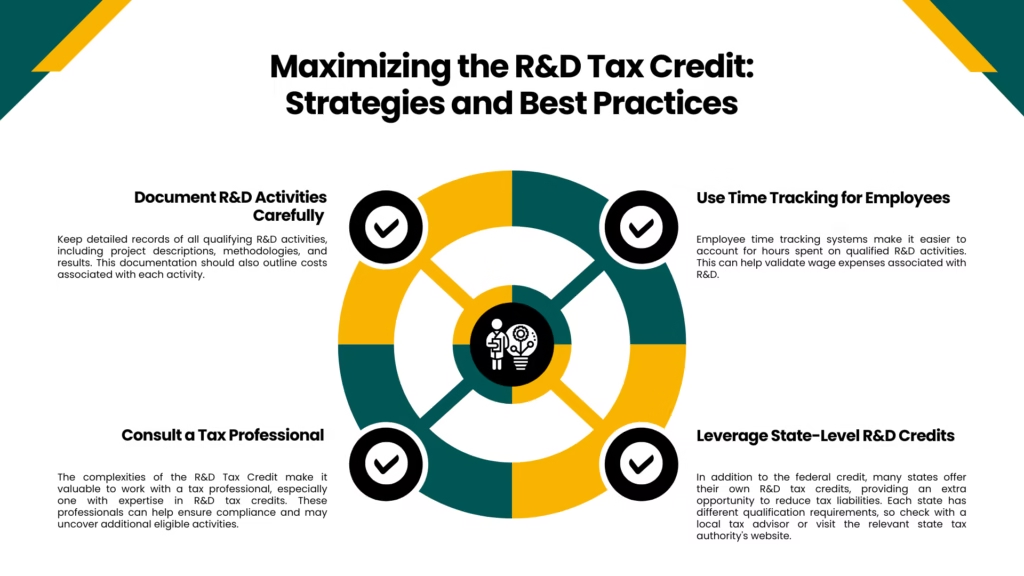The Research and Development (R&D) Tax Credit is a valuable opportunity for businesses involved in innovation to offset their income or payroll taxes. Established in 1981, the R&D Tax Credit incentivizes companies to engage in qualified research and development activities, allowing them to claim credits against expenses related to developing or improving products, processes, software, or other innovative projects. Businesses that meet certain criteria can benefit significantly, but the qualification process can be complex. This guide will cover the basics of the R&D Tax Credit, the qualifications required, and strategies to maximize benefits.
What is the R&D Tax Credit?
The R&D Tax Credit is a federal incentive designed to reward U.S.-based businesses for investing in innovation. Companies in a wide range of industries, from manufacturing to software development, can potentially claim this credit for activities such as designing new products, improving manufacturing processes, developing software, or innovating through engineering.
For tax years beginning in 2016, small businesses (those with less than $50 million in gross receipts) may claim the credit against their alternative minimum tax, and some startups (those with less than $5 million in gross receipts and within five years of formation) can apply the credit toward payroll taxw the R&D Tax Credit Works
The R&D Tax Credit allows businesses to reduce their tax liability based on a percentage of qualifying R&D expenditures. Qualifying costs typically include:
- Wages paid to employees directly involved in R&D activities.
- Supplies used in R&D processes.
- Contract research expenses if a third party conducts R&D on behalf of the business.
These expenses contribute to a company’s R&D tax credit calculation, which offsets a portion of its federal tax liabilities. In some cases, unused credits can be carried forward to future tax years.
To calculate the credit, businesses can use one of two main methods:
- Regular Research Credit (RRC): The RRC is a traditional method that applies a fixed base percentage (20%) of qualified expenses against a base amount. This method works best for businesses with consistent R&D spending over time.
- Alternative Simplified Credit (ASC): The ASC allows businesses to calculate the credit as a percentage (usually 14%) of the increase in qualifying expenses over a set base period. The ASC is often more accessible for companies with less consistent R&D expenditures.
Qualifying for the R&D Tax Credit
To qualify, businesses must demonstrate that their activities meet the IRS’s Four-Part Test. Here’s what the IRS looks for in each part of the test:
- Permitted Purpose: The activity must aim to develop or improve a product, process, technique, formula, invention, or software. This purpose should be intended for use in a commercial setting, though experimental products qualify as well.
- Elimination of Uncertainty: The business must attempt to eliminate uncertainty regarding the development or improvement of a product or process. Uncertainties may include questions about design, capability, or the proper methodology.
- Process of Experimentation: To qualify, the activity should involve a systematic process of experimentation, such as testing, trial and error, or prototyping, to resolve uncertainties.
- Technical in Nature: The work should rely on principles of hard sciences, like engineering, biology, physics, or computer science. Activities rooted in non-scientific disciplines (e.g., marketing) do not qualify.
If these criteria are met, a business can apply for the credit by documenting the costs associated with qualifying activities and submitting the appropriate tax forms (usually IRS Form 6765).
Eligible Expenses Under the R&D Tax Credit
Eligible expenses include:
- Employee Wages: Salaries and wages for employees directly involved in qualified R&D activities are eligible. This includes wages for those in supervisory roles or who provide support to the R&D process.
- Supplies and Materials: Materials used in the development of a prototype or for trial purposes are considered qualified expenses.
- Contracted R&D Costs: Expenses for third-party research contractors may qualify, provided the third party is engaged in eligible R&D activities.
- Cloud Computing Costs: As of recent guidance, cloud computing costs related to R&D may be deductible, which is beneficial for companies involved in software development and other digital fields.
For more details on qualified expenses, you can visit the IRS’s official page on R&D credits.

Maximizing the R&D Tax Credit: Strategies and Best Practices
To fully benefit from the R&D Tax Credit, companies should adopt practices that simplify documentation and substantiate their claims:
- Document R&D Activities Carefully: Keep detailed records of all qualifying R&D activities, including project descriptions, methodologies, and results. This documentation should also outline costs associated with each activity.
- Use Time Tracking for Employees: Employee time tracking systems make it easier to account for hours spent on qualified R&D activities. This can help validate wage expenses associated with R&D.
- Consult a Tax Professional: The complexities of the R&D Tax Credit make it valuable to work with a tax professional, especially one with expertise in R&D tax credits. These professionals can help ensure compliance and may uncover additional eligible activities.
- Leverage State-Level R&D Credits: In addition to the federal credit, many states offer their own R&D tax credits, providing an extra opportunity to reduce tax liabilities. Each state has different qualification requirements, so check with a local tax advisor or visit the relevant state tax authority’s website.
For example, the State of California offers an R&D tax credit that provides additional savings for qualifying expenses. More information is available on the California Franchise Tax Board’s website.
Benefits of the R&D Tax Credit
The R&D Tax Credit is more than a tax break; it can play a vital role in a business’s financial health. Some of the notable benefits include:
- Increased Cash Flow: By reducing federal tax liabilities, businesses retain more cash to reinvest in growth, hire new employees, or enhance R&D efforts.
- Encouragement of Innovation: The credit encourages innovation by rewarding businesses for taking risks and advancing technological development.
- Payroll Tax Offset for Startups: Early-stage businesses often lack income tax liabilities but may have payroll taxes. For these startups, the R&D tax credit can be applied toward up to $250,000 of payroll tax, which offers a valuable opportunity to manage operating costs.
For detailed guidance on startup eligibility and how the payroll tax offset works, the IRS provides an overview of the qualifications on its startup eligibility page.
Common Misconceptions about the R&D Tax Credit
Many companies miss out on the R&D tax credit due to misconceptions, such as:
- “We don’t have a lab or scientists”: R&D does not require a lab or a team of scientists. Any company that follows a process of experimentation and technological advancement can potentially qualify, including software developers, manufacturers, and engineers.
- “We’re too small to benefit”: Small businesses and startups often benefit from the R&D credit, particularly the payroll tax offset. Even if your company doesn’t have substantial profits, it may still receive benefits under the payroll offset provision.
- “Only high-tech or pharmaceutical companies qualify”: While high-tech and pharmaceutical companies often utilize the credit, businesses in many industries can qualify. For example, manufacturing, agriculture, architecture, and engineering are all industries where the R&D credit is frequently applied.
How to Apply for the R&D Tax Credit
The application process for the R&D Tax Credit includes a few key steps:
- Document All Qualifying R&D Activities and Expenses: Before claiming the credit, you need to have clear documentation supporting your R&D activities and associated costs. This includes keeping detailed records and project reports.
- Complete IRS Form 6765: Businesses applying for the credit must file Form 6765, “Credit for Increasing Research Activities,” with their tax return. The form calculates the total R&D credit and is available on the IRS website.
- File State R&D Credit Applications (if applicable): Companies applying for state R&D credits may need to file additional forms specific to each state’s requirements.
- Consult a Qualified Tax Professional: Given the detailed nature of R&D credit applications, a tax professional can help ensure that your claim meets all regulatory requirements and maximizes benefits.
Final Thoughts
The R&D Tax Credit can be a game-changer for innovative companies. Whether you’re a startup exploring payroll tax offsets or an established business looking to reduce federal and state income taxes, this credit rewards your efforts to advance technology and improve processes. However, navigating the rules and maximizing the credit requires careful documentation and sometimes professional assistance.
By understanding eligibility requirements and adopting best practices, businesses can leverage the R&D Tax Credit to invest in future growth while benefiting from significant tax savings. For more details on federal eligibility, visit the IRS’s page on the R&D Tax Credit.
